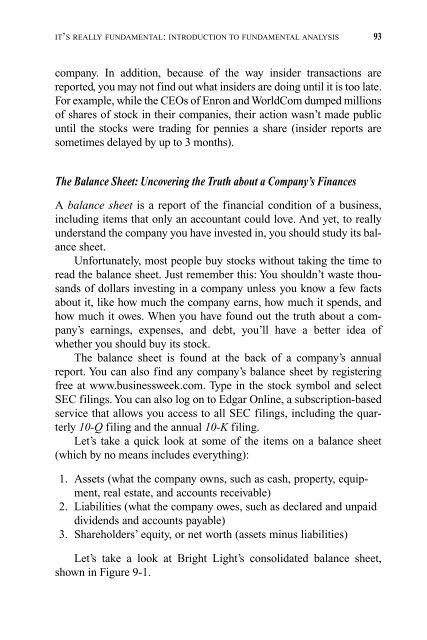Understanding Stocks
Understanding Stocks
Understanding Stocks
Create successful ePaper yourself
Turn your PDF publications into a flip-book with our unique Google optimized e-Paper software.
IT’S REALLY FUNDAMENTAL: INTRODUCTION TO FUNDAMENTAL ANALYSIS 93<br />
company. In addition, because of the way insider transactions are<br />
reported, you may not find out what insiders are doing until it is too late.<br />
For example, while the CEOs of Enron and WorldCom dumped millions<br />
of shares of stock in their companies, their action wasn’t made public<br />
until the stocks were trading for pennies a share (insider reports are<br />
sometimes delayed by up to 3 months).<br />
The Balance Sheet: Uncovering the Truth about a Company’s Finances<br />
A balance sheet is a report of the financial condition of a business,<br />
including items that only an accountant could love. And yet, to really<br />
understand the company you have invested in, you should study its balance<br />
sheet.<br />
Unfortunately, most people buy stocks without taking the time to<br />
read the balance sheet. Just remember this: You shouldn’t waste thousands<br />
of dollars investing in a company unless you know a few facts<br />
about it, like how much the company earns, how much it spends, and<br />
how much it owes. When you have found out the truth about a company’s<br />
earnings, expenses, and debt, you’ll have a better idea of<br />
whether you should buy its stock.<br />
The balance sheet is found at the back of a company’s annual<br />
report. You can also find any company’s balance sheet by registering<br />
free at www.businessweek.com. Type in the stock symbol and select<br />
SEC filings. You can also log on to Edgar Online, a subscription-based<br />
service that allows you access to all SEC filings, including the quarterly<br />
10-Q filing and the annual 10-K filing.<br />
Let’s take a quick look at some of the items on a balance sheet<br />
(which by no means includes everything):<br />
1. Assets (what the company owns, such as cash, property, equipment,<br />
real estate, and accounts receivable)<br />
2. Liabilities (what the company owes, such as declared and unpaid<br />
dividends and accounts payable)<br />
3. Shareholders’ equity, or net worth (assets minus liabilities)<br />
Let’s take a look at Bright Light’s consolidated balance sheet,<br />
shown in Figure 9-1.

















